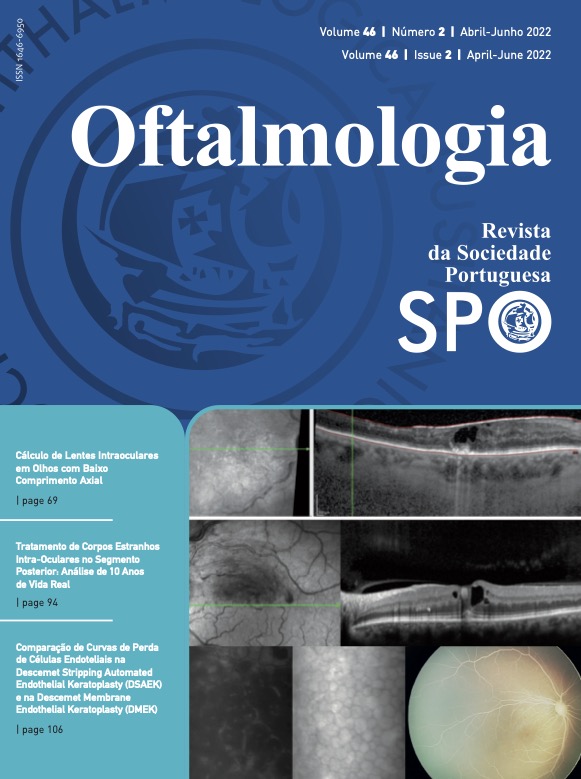Comparison between Automatic Segmentation of the Optical Disc by SD-OCT and Stereo Retinography
DOI:
https://doi.org/10.48560/rspo.23334Keywords:
Glaucoma, Retinoscopy, Tomography, Optical CoherenceAbstract
INTRODUCTION: The cup-to-disc (c/d) ratio, defined as the ratio of the optic disc cup and neuroretinal rim surfaces, is an important structural indicator for assuming glaucomatous damage and the historic landmark in the diagnosis and assessment of disease progression. We purpose to compare the automatic evaluation of the planimetric parameters of the optical disc by SD-OCT, with optic disc color fundus photographs (CFP) reviewed by two ophthalmologists with different experience levels.
METhODS: Observational and cross-sectional study including 64 eyes of patients followed up for glaucoma or suspected glaucoma (including ocular hypertension), who underwent stereoscopic CFP and evaluation by SD-OCT on the same day. We excluded patients with opaque media that can jeopardize image evaluation. Two graders, 1 glaucoma specialist (G1 - gold standard), and 1 ophthalmology resident (G2), blindly classified each stereo pair of CFP according to the vertical and horizontal cup-to-disk, among other qualitative parameters of the disk. The correlation between both was analyzed, as did with the OCT.
RESULTS: Graders differed by an average of 0.05 ± 0.09 (range -0.19-0.22) (p = 0.05) and 0.08 ± 0.11 (range -0.27-0.31) (p <0.01) in the vertical and horizontal ratio, respectively. The agreement between graders was Good (ICC = 0.82 and 0.81). G1 and G2 differed from OCT on 0.07(±0.01)/0.13(±0.02)/ and 0.03(±0.02)/0.06(±0.02)(vertical/horizontal). These differences were statistically significant (p <0.01), except for the vertical cup-to-disk ratio between G2 and OCT (p= 0.06). The mixed correlation between G1 and G2 with the OCT was Excellent (ICC = 0.91) for the vertical ratio, and Good (ICC=0.83) for the horizontal ratio. The difference in classification between G1 and OCT was not correlated with the disc area (B = 0.16, p = 0.15 nor with peripapillary atrophy ((B = -0.02, p=0.31).
CONCLUSION: In our study, we obtained a Good correlation in the optic disc analysis between a young ophthalmologist and a more experienced one, reassuring the importance of this classic sign in clinical practice. The OCT also obtained good reproducibility, with a possible increasing applicability in telemedicine. However, human evaluation maintains its clinical relevance, as it is more sensitive to anomalous discs and allowing a qualitative analysis of it.
Downloads
References
Quigley H, Broman AT. The number of people with glaucoma worldwide in 2010 and 2020. Br J Ophthalmol. 2006;90:262-7. doi:10.1136/bjo.2005.081224
Heijl A, Leske MC, Bengtsson B, Hyman L, Hussein M. Reduction of intraocular pressure and glaucoma progression. Evid Based Eye Care. 2003;4:137-9. doi:10.1097/00132578-200307000-00009
Mitchell P, Smith W, Attebo K, Healey PR. Prevalence of open-angle glaucoma in Australia: The blue mountains eye study. Ophthalmology. 1996;103:1661-9. doi:10.1016/S0161-6420(96)30449-1
Tielsch J, Sommer A, Katz J. Racial variations in the prevalence of primary open-angle glaucoma. JAMA Ophthalmol. 1991;266:369- 374.
Kwon YH, Adix M, Zimmerman MB, Piette S, Greenlee EC, Alward WL, et al. Variance owing to observer, repeat imaging, and fundus camera type on cup-to-disc ratio estimates by stereo planimetry. J Glaucoma. 2009;18:305-10. doi:10.1097/IJG.0b013e318181545e
Mwanza JC, Oakley JD, Budenz DL, Anderson DR; Cirrus Optical Coherence Tomography Normative Database Study Group. Ability of CirrusTM HD-OCT Optic Nerve Head Parameters to Discriminate Normal from Glaucomatous Eyes. Ophthalmology. 2011;118:241–8. doi:10.1016/j.ophtha.2010.06.036.Ability
Budenz DL, Fredette MJ, Feuer WJ, Anderson DR. Reproducibility of Peripapillary Retinal Nerve Fiber Thickness Measurements with Stratus OCT in Glaucomatous Eyes. Ophthalmology. 2008;115. doi:10.1016/j.ophtha.2007.05.035
Karvonen E, Stoor K, Luodonpaa M, Hägg P, Lintonen T, Liinamaa J, et al. Diagnostic performance of modern imaging instruments in glaucoma screening. Br J Ophthalmol. 2020;104:1399-405. doi:10.1136/bjophthalmol-2019-314795
Mills RP, Budenz DL, Lee PP, Noecker RJ, Walt JG, Siegartel LR, et al. Categorizing the stage of glaucoma from pre-diagnosis to end-stage disease. Am J Ophthalmol. 2006;141:24-30. doi:10.1016/j. ajo.2005.07.044
Mesiwala NK, Pekmezci M, Porco TC, Lin SC. Optic disc param- eters from optovue optical coherence tomography: Comparison of manual versus automated disc rim determination. J Glaucoma. 2012;21367-71. doi:10.1097/IJG.0b013e31821206e8
Koo TK, Li MY. A Guideline of Selecting and Reporting Intraclass Correlation Coefficients for Reliability Research. J Chiropr Med. 2016;15:155-63. doi:10.1016/j.jcm.2016.02.012
Lichter PR. Variability of expert observers in evaluating the optic disc. Trans Am Ophthalmol Soc. 1977;74:532-72.
Tielsch JM, Katz J, Quigley HA, Miller NR, Sommer A. Intraobserver and Interobserver Agreement in Measurement of Optic Disc Characteristics. Ophthalmology. 1988;95:350-6. doi:10.1016/ S0161-6420(88)33177-5
Hatch W V, Trope GE, Buys YM, Macken P, Etchells E, Flanagan JG. Agreement in assessing glaucomatous discs in a clinical teach- ing setting with stereoscopic disc photographs, planimetry, and laser scanning tomography. J Glaucoma. 8:99-104.
Abràmoff MD, Lavin PT, Birch M, Shah N, Folk JC. Pivotal trial of an autonomous AI-based diagnostic system for detection of diabetic retinopathy in primary care of fi ces. npj Digit Med. 2018;39. doi:10.1038/s41746-018-0040-6
Sharma A, Oakley JD, Schiffman JC, Budenz DL, Anderson DR. Comparison of Automated Analysis of Cirrus HD-OCTTM Spectral Domain Optical Coherence Tomography with. Ophthalmology. 118:1348–57.
Badalà F, Nouri-Mahdavi K, Raoof DA, Leeprechanon N, Law SK, Caprioli J. Optic Disk and Nerve Fiber Layer Imaging to Detect Glaucoma. Am J Ophthalmol. 2007;144:724-32. doi:10.1016/j. ajo.2007.07.010
Abràmoff MD, Lee K, Niemeijer M, Alward WL, Greenlee EC, Garvin MK, et al. Automated segmentation of the cup and rim from spectral domain OCT of the optic nerve head. Investig Ophthalmol Vis Sci. 2009;50:5778-84. doi:10.1167/iovs.09-3790
Downloads
Published
How to Cite
Issue
Section
License
Copyright (c) 2022 Revista Sociedade Portuguesa de Oftalmologia

This work is licensed under a Creative Commons Attribution-NonCommercial 4.0 International License.
CC BY
Do not forget to download the Authorship responsibility statement/Authorization for Publication and Conflict of Interest.
The article can only be submitted with these two documents.
To obtain the Authorship responsibility statement/Authorization for Publication file, click here.
To obtain the Conflict of Interest file (ICMJE template), click here







